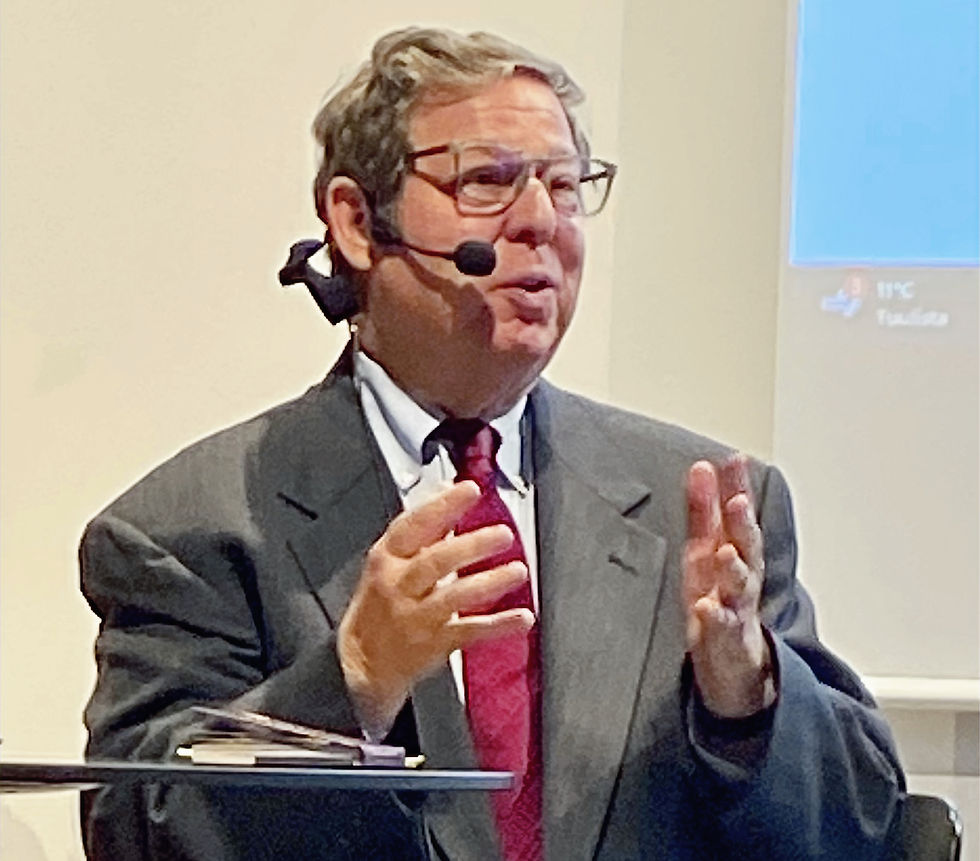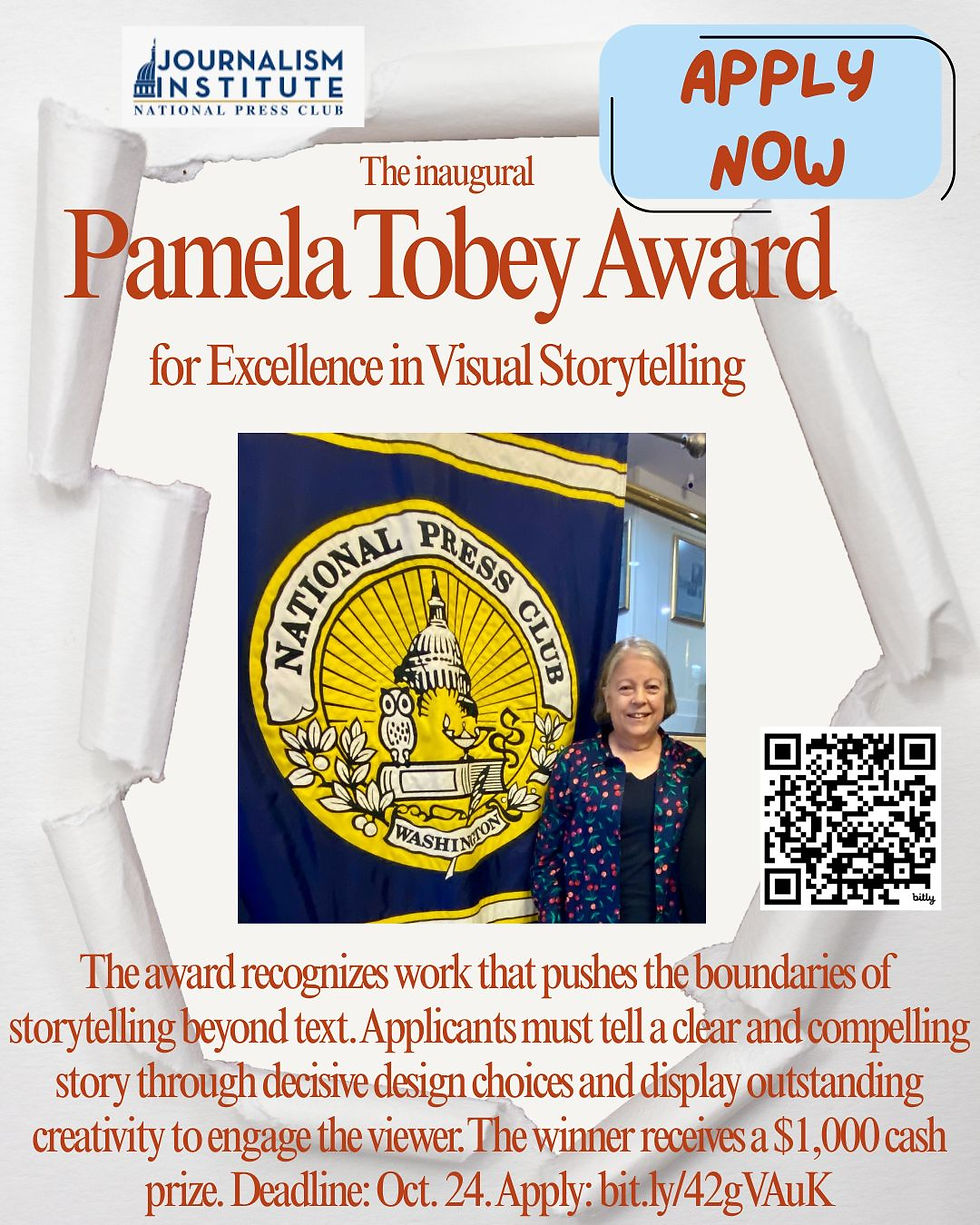September Newsletter: A new semester of Global Business Journalism classes and activities; hot topics on front burner
- Rick Dunham
- Oct 2
- 8 min read

GLOBAL BUSINESS JOURNALISM NEWSLETTER
September 2025

Just like that, the incoming class of 2025 has completed orientation and is deep into the new semester. We're already through the drop-and-add part of the fall semester and ready for the October holiday break (all too early this year).
Welcome to the new Global Business Journalism incoming students. Vietnam boasts the largest number of first-year GBJers with three, followed by the United States, Russia and Malaysia with two. We also have our first student from the South American nation of Guyana.
Our diversity is our strength. And now GBJ can increase our global tally to 77 countries taking part in the program since our founding in 2007. Truly a United Nations of Journalism.
Here are some news highlights from the past month.
It's a G-2 world, Chinese journalist Wu Chen tells GBJ students in Hot Topics class

Wu Chen, a journalist, author, and former Managing Director of The Economist Global Business Review, believes the geopolitical story of the coming decades will center on two powers: the United States and China.
“The whole global order constructed by the United States after World War II is now in Tetris,” he told students in the Global Business Journalism program's Hot Topics course on September 22, describing a system shifting piece by piece but no longer stable.
The China-U.S. economic relationship, once interdependent, has fractured. The United States, Wu said, remains the champion of breakthroughs, “from zero to one,” like the leap that produced ChatGPT. China, by contrast, thrives at scaling innovations “from one to 100.”
Governance also reflects these contrasts.
“In China, engineers govern. In the United States, it’s lawyers, and that leads to gridlock,” he said.
Wu argued that lawyers are the one that “couldn't get things done," contrasting sharply with China's engineer-driven governance, which executes projects and builds things rapidly.
Financial dynamics are shifting too. The weakening dollar has fueled speculation about China’s currency and the possible rise of stablecoins for global trade.
“Everything’s a deal now,” Wu said, likening the moment to Donald Trump’s transactional worldview in "The Art of the Deal."
A challenge for China is to create the “cool factor,” something that creates global curiosity, encouraging people outside of the country to engage with its entire system, not just its products, especially given that COVID-19 blocked access and understanding.
Wu Chen is a columnist for The Economic Observer and the author of five books, including a trilogy on innovation and technology. He previously worked for the Economist Global Business Review, with a career spanning BusinessWeek, Bloomberg and CFO China.
— Item written by Han Vu
Rick Dunham discusses American media situation at international conference in Finland

Global Business Journalism co-director Rick Dunham took part in the annual Tampere Freedom of Speech forum in Finland from September 22 to 24, delivering a speech and participating in an event at the city hall and a roundtable discussion at Tampere University. Other participants included Kathleen Carroll, the retired executive editor of the Associated Press and board chairman of the Committee to Protect Journalists, award-winning Colombian photographer Federico Rios, Finnish editor Matti Posio and other leading Finnish journalists and academics.
Professor Dunham discussed free speech issues in the United States during the second administration of President Donald Trump and also discussed China's economic and diplomatic influence in the world. China's economic rise has been a major topic in Finland this year as a result of a best-selling book by Finnish journalist Mika Hentunen, a former GBJ visiting scholar, and business consultant Kristiina Helenius, a GBJ guest lecturer. Mika Hentunen, now the Moscow correspondent for YLE Finnish broadcasting, joined Professor Dunham to discuss China and the United States during a lively session on September 22.
GBJ students join calligraphy workshop: Where disciplined tradition meets individual style

Global Business Journalism students explored the art of Chinese calligraphy and its deep connection to Chinese culture on Sept. 20. The workshop offered students an opportunity to experience how centuries-old techniques meet personal expression, revealing the balance between structure and creativity in this unique art form.
The workshop, held in Building C at Tsinghua University, welcomed students of all skill levels — from complete beginners to those seeking to refine their technique. A total of 12 students participated in the session, which marked the third consecutive year the event has been held. Lizzy Guo (Jingchao), a Ph.D. student in the College of Fine Arts at Tsinghua, served as the main instructor.
“Each semester focuses on teaching one character or one script style, with activities like fan painting interspersed throughout," she explained. "This way, participants can genuinely learn something from the workshop."
The first part of the workshop introduced the basics of calligraphy, including an overview of key strokes and the differences between Chinese and English calligraphy. Students learned that while both forms are artistic, Chinese calligraphy emphasizes structure, stroke order, and subtle variations in brush pressure, creating what some describe as “silent music” on paper. The class also traced the art’s historical evolution, from oracle bone inscriptions to small seal script, official script, and regular script. The students discovered that even within a single era, individual calligraphers expressed unique aesthetic choices.
The second part of the workshop took place at the Tsinghua Art Museum, where students visited the special exhibition “Celebrating the Artistic and Scholarly Kinship of Qi Gong and Xu Wuwen.” Both masters, celebrated in the 20th century for their calligraphy, painting, and seal carving, were not only eminent artists but also lifelong teachers and scholars. Qi Gong, a professor at Beijing Normal University, was admired for his elegant, flowing brushwork and his erudition in philology, epigraphy and art history. Xu Wuwen, professor at Southwest Normal University, mastered a wide range of calligraphic styles and was equally renowned for his seal carving.
The exhibition revealed that despite working within strict traditions — copying classical scripts such as seal and clerical styles — both masters infused their works with individuality. This method, known as linmo (临摹), allows creators to intertwine the defining features of pre-existing styles with their own artistic touch. It remains a central approach to developing a deeper understanding of modern Chinese calligraphy.
“Calligraphy symbolizes the vitality and continuity of our culture, passed down through generations,” instructor Guo shared with GBJ students. “Today, when we learn calligraphy, we draw inspiration from the works of the ancients and integrate them into our contemporary creations. Its form and appearance today also reflect our current understanding of traditional calligraphy, and we have given it new interpretations.”
Calligraphy workshop sessions take place every Saturday afternoon in Building C. The seconde session is to focus on the works of Zao Quanbei, a calligrapher of the Eastern Han dynasty.
— Item written by Faezeh Mirzabeh and Milena Kuzhakova
Pamela Tobey visual storytelling award is launched

The National Press Club Journalism Institute has announced the creation of the Pamela Tobey Award for Excellence in Visual Storytelling, made possible through the generosity of Rick Dunham, former president of both the National Press Club and the Institute, and his wife, Pamela Tobey, a distinguished graphics editor formerly of The Washington Post.
The award honors Tobey’s cutting-edge work in visual journalism and her commitment to advancing innovative storytelling. Dunham and Tobey have invested an initial $20,000 endowment, with plans to fully fund the award at $50,000 within five years.
Dunham has been co-director of the Global Business Journalism program at Tsinghua University since 2013. Tobey has been a visiting professor in the GBJ program, teaching Business News Data Visualization, and has conducted workshops and training sessions for students and journalism professionals.
“Pamela Tobey’s career exemplifies the power of visual journalism to connect with audiences in fresh and compelling ways,” said Ed Kelley, president of the National Press Club Journalism Institute. “We are deeply grateful to Rick and Pam for entrusting the Institute to carry forward their vision of elevating design innovation in journalism.”
The first Tobey Award will be given out in mid-November in conjunction with the Tsinghua Business Journalism Forum at the National Press Club in Washington, D.C. The deadline for applications is October 24.
GBJ students explore cutting-edge cell science with Professor Anthony Hyman

Professor Anthony A. Hyman, a world-renowned geneticist, encouraged Tsinghua students to explore the unknowns in life sciences, maintain curiosity and enduring passion for scientific questions, and focus on pursuing significant fundamental research with persistence.
At a Sept. 25 presentation that attracted nearly 400 faculty and students from various Tsinghua departments, including Global Business Journalism, the School of Life Sciences, Department of Chemistry and ZhiLi College, Professor Hyman stressed the urgent need for better data, noting that collecting high-quality physical data, such as detailed phase diagrams, is crucial for the future, especially for leveraging tools like Artificial Intelligence (AI) by constraining the models using physical rules. This emphasis suggests that combining life sciences with robust physical chemistry principles is the paradigm shift for the next generation.
Hyman, director of the Max Planck Institute of Molecular Cell Biology and Genetics (MPI-CBG) and a pioneer in the field of biological phase separation, delivered the 257th Tsinghua Global Vision Lecture, titled "Biomolecular Condensates and Their Implications for Cell Physiology and Disease." He is widely recognized as a pioneer in the study of biological phase separation. In his lecture, he outlined his team’s extensive research progress in the field and traced the evolution of the phase separation concept.
Hyman explained how biomolecular condensates — formed through liquid–liquid phase separation within cells — play dynamic roles in regulating vital physiological processes such as cell division, signaling and stress response. He also highlighted growing evidence that abnormal phase separation may contribute to a range of diseases, including neurodegenerative disorders.
Since 2007, the Tsinghua Global Vision Lecture Series has hosted 257 talks by leading figures in science, technology, and global affairs, including Nobel laureates, international dignitaries and industry leaders.
— Item written by Han Vu
6. Check out our latest journalism tipsheets and news updates from GlobalBusinessJournalism.com

Here are some stories we've published on our website since the beginning of the summer break, in case you've missed them:
Economic journalism tips
Business journalism's five pillars of purpose: Rick Dunham discusses the mission of economic reporting
10 ways to effectively cover macroeconomic news for a global audience
A journalist's guide to reporting on ESG and the geopolitics of sustainability
How you can better cover international trade: Explaining tariffs
U.S.-China trade tensions: Their causes and consequences
A complete chronology of the 2025 U.S.-China trade tensions
Reporting and multimedia tips
7 (mostly) free audio and video editing tools for journalists
5 tips for turning your news article into a short-form video
How journalists can create viral posts on TikTok — containing useful and accurate information
Can one person be a journalist, an influencer and a content creator?
Solutions Journalism: How to conceptualize — and then pitch — your story
Tips for visual journalists covering crisis situations
How "deep listening" can make you a better interviewer — some practical tips
Commencement 2025: Complete coverage
>>> Dean Zhou Qing'an: Class of 2025 carved "a unique path to success" through pandemic-era challenges
>>> Professor Rick Dunham to 2025 graduates: "You are prepared to be influential international players"
Thanks for reading the GBJ newsletter. We'll be back with more news and updates from students, alumni and faculty next month. If you want to be the first to read each GBJ newsletter, subscribe here and receive an email notification when a new newsletter is published.









It’s great to see the exciting new semester of Global Business Journalism classes and activities! For anyone looking to enter the journalism field, a well-crafted application is key. If you’re in NZ and need help with your job applications, an NZ cover letter writer can help you create a compelling cover letter that highlights your skills and experience.